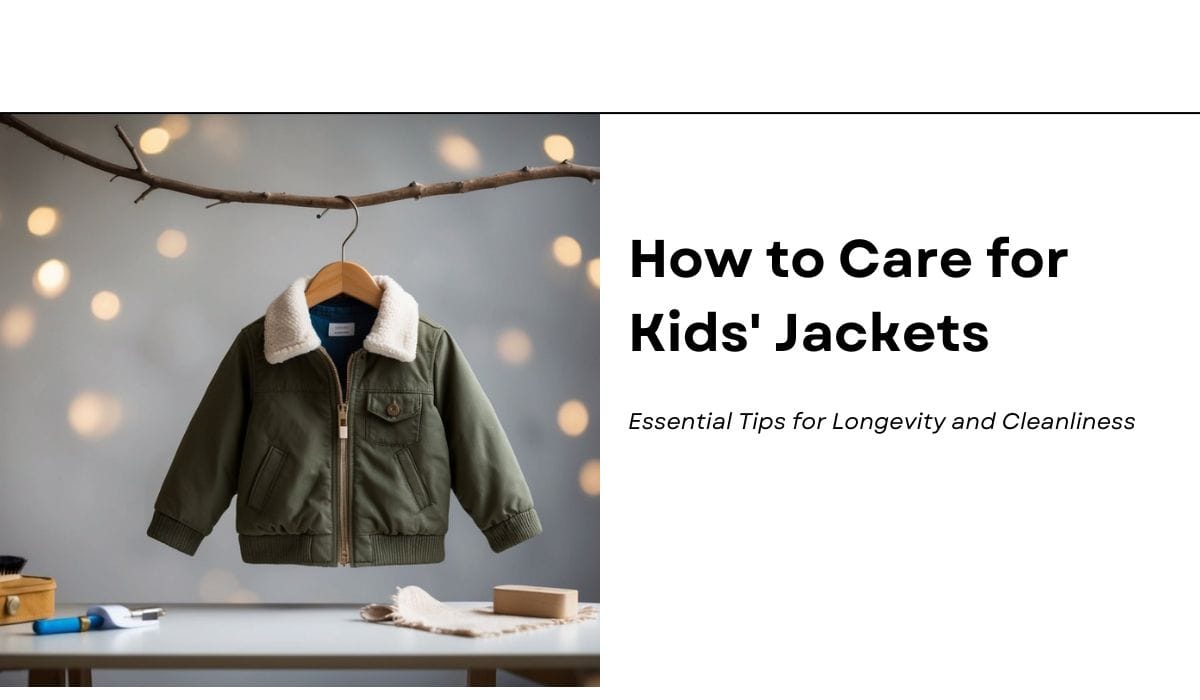Kids’ jackets take a beating from playground adventures to messy meals. Keeping them clean and in good shape can be a challenge for parents. But with a few simple tips, we can make those coats last longer and look better.
The key to caring for kids’ jackets is to follow the care label instructions and clean them as needed. For lighter rain jackets, a quick wipe with a damp cloth often does the trick. Heavier coats like puffers may need washing more often, but always check the label first.
I’ve found that regular cleaning helps keep jackets fresh and extends their life. For waterproof coats, it’s important to reactivate the water-repellent treatment. This can be done by drying them on low heat in a tumble dryer or ironing them on a low setting.
On This Page
Key Takeaways
- Check care labels and clean jackets according to their specific fabric needs
- Wipe light jackets clean regularly and wash heavier coats as needed
- Reactivate water-repellent coatings to maintain jacket performance
Understanding Jacket Materials and Types
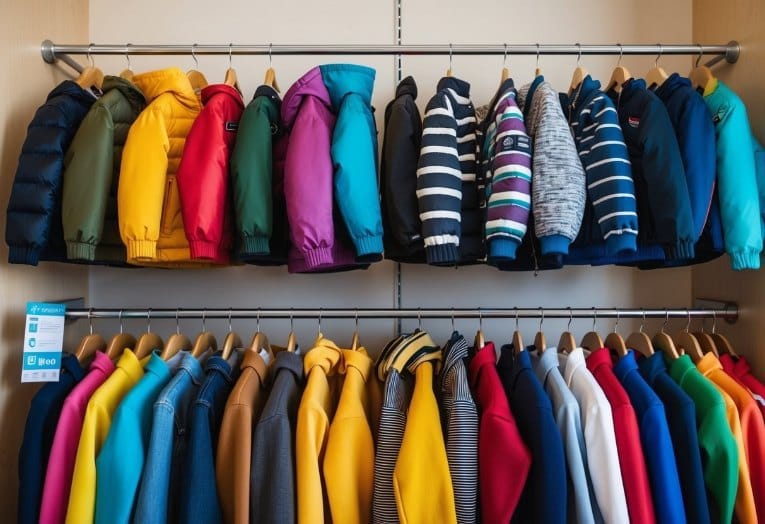
Kids’ jackets come in many materials and styles to suit different needs. I’ll cover the main types and fabrics you’ll find when shopping for children’s outerwear.
Identifying Different Materials
Wool is a warm, natural fabric great for cold weather. It’s durable but can be itchy for some kids. Down jackets use fluffy feathers for insulation. They’re very warm and lightweight, but not waterproof on their own. Synthetic materials like polyester are common in kids’ jackets. They’re often cheaper and easier to clean than natural fabrics.
Waterproof jackets typically use nylon or polyester with a special coating. This keeps kids dry in rain and snow. Some jackets mix materials for the best features. A fleece lining adds warmth to a waterproof shell, for example.
Types of Children’s Jackets
Winter coats are thick, insulated jackets for very cold weather. They often have hoods and extra features to block wind and snow. Rain jackets are lightweight and waterproof, perfect for drizzly days. They’re usually made of thin nylon or polyester.
Puffer coats use down or synthetic fill in quilted sections. This traps heat well and gives them a puffy look. 3-in-1 jackets have removable layers. Kids can wear the outer shell as a rain jacket, the inner layer as a light jacket, or both together for cold weather.
Some jackets are made for specific activities. Ski jackets, for instance, are waterproof and have special pockets for lift tickets.
Reading and Interpreting Care Labels
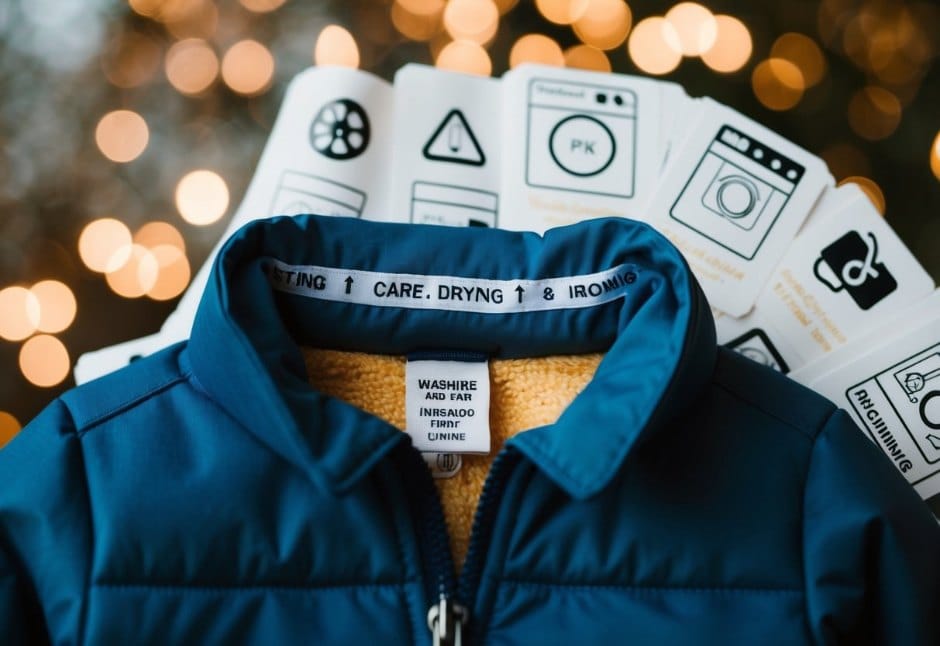
Care labels are vital for keeping kids’ jackets in good shape. I’ll explain how to read these labels so you can wash and dry jackets properly.
Most labels use symbols to show how to care for the item. Here are some common ones:
- 🌊 Washing machine symbol
- 🔺 Tumble dry symbol
- ☐ Flat dry symbol
- 🛇 Do not wash symbol
The number of dots inside these symbols tells you the temperature to use. More dots mean higher heat.
Some labels also have written instructions. They might say “Machine wash cold” or “Tumble dry low”. These are easy to follow.
I always check for special notes like “No bleach” or “Dry clean only”. These help avoid damage to the jacket.
If a label is missing or unclear, I play it safe. I use cold water and gentle cycle for washing. For drying, I hang the jacket or use low heat.
Reading care labels takes practice, but it’s worth it. It keeps kids’ jackets looking good and lasting longer.
Routine Cleaning and Maintenance

Keeping kids’ jackets clean and well-maintained is key to their longevity. I’ll cover some simple tips for washing, stain removal, and proper storage to help jackets last all season.
Regular Washing Tips
I recommend washing kids’ jackets every few weeks, or when visibly dirty. For most jackets, I use the gentle cycle with cold water and a mild detergent. I avoid washing heavy coats too often, as it can wear down the fabric.
For puffer jackets, I use a low spin speed of about 800 RPM. Near the end of the cycle, I increase it to 1000 RPM to remove excess water.
I always zip up jackets and turn them inside out before washing. This protects the outer fabric and prevents snagging.
For wool coats, I use a wool-safe detergent like Woolite. I wash these on the delicate cycle with cold water to prevent shrinking.
Managing Tough Stains
I always pre-treat stains before washing. For most stains, I use a bit of liquid detergent and gently rub it in with my fingers.
For mud or dirt, I let it dry completely, then brush off as much as I can. I spot clean the area with a damp cloth and mild soap.
Salt stains on boots are tricky. I mix equal parts water and white vinegar. I dab this on the stain, then wipe with a clean, damp cloth.
For grease stains, I sprinkle some cornstarch or talcum powder on the spot. I let it sit for a few hours to absorb the oil, then brush it off.
Drying and Storage
I always air dry jackets to prevent shrinking and damage. I hang them on a sturdy hanger or lay them flat to dry.
For puffy jackets, I toss in a few clean tennis balls during the dryer cycle. This helps fluff up the filling and prevent clumping.
I never store jackets when damp. This can lead to mould and musty smells. I make sure they’re completely dry first.
Between wears, I hang jackets on padded hangers to keep their shape. For long-term storage, I use breathable garment bags to protect from dust.
Seasonal Care for Kids’ Jackets
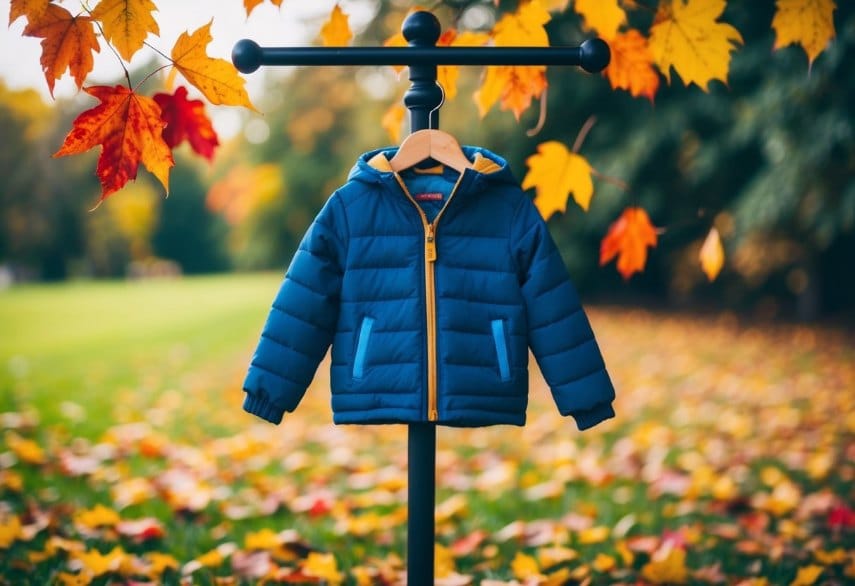
Looking after kids’ jackets properly helps them last longer and perform better. I’ll cover how to care for winter coats and rain jackets to keep kids warm and dry all year round.
Caring for Winter Jackets
Winter jackets need special care to stay warm and cosy. For down jackets and puffer coats, I wash them in cold water on a gentle cycle. I use a mild soap made for down. After washing, I dry them on low heat with a few tennis balls to fluff up the down.
Wool coats are trickier. I spot clean stains right away. For a full wash, I use cold water and wool-safe soap. I never put wool in the dryer – it can shrink. I lay it flat to dry instead.
For all winter coats, I store them clean and dry. I use padded hangers to keep their shape. A garment bag protects them from dust and moths.
Maintaining Rain Jackets
Waterproof jackets need care to stay water-resistant. I wash them separately in cold water with a special cleaner for waterproof gear. I avoid fabric softener – it can hurt the waterproofing.
I dry rain jackets on low heat or air dry them. Once dry, I use a spray-on water repellent to boost their performance. I do this once or twice a season.
Between washes, I wipe off mud and dirt with a damp cloth. This keeps the jacket breathing well. For stubborn stains, I use a soft brush and mild soap.
I hang rain jackets to air out after each use. This prevents mould and musty smells. I also check and clean the zips to keep them working smoothly.
Preserving Jacket Integrity
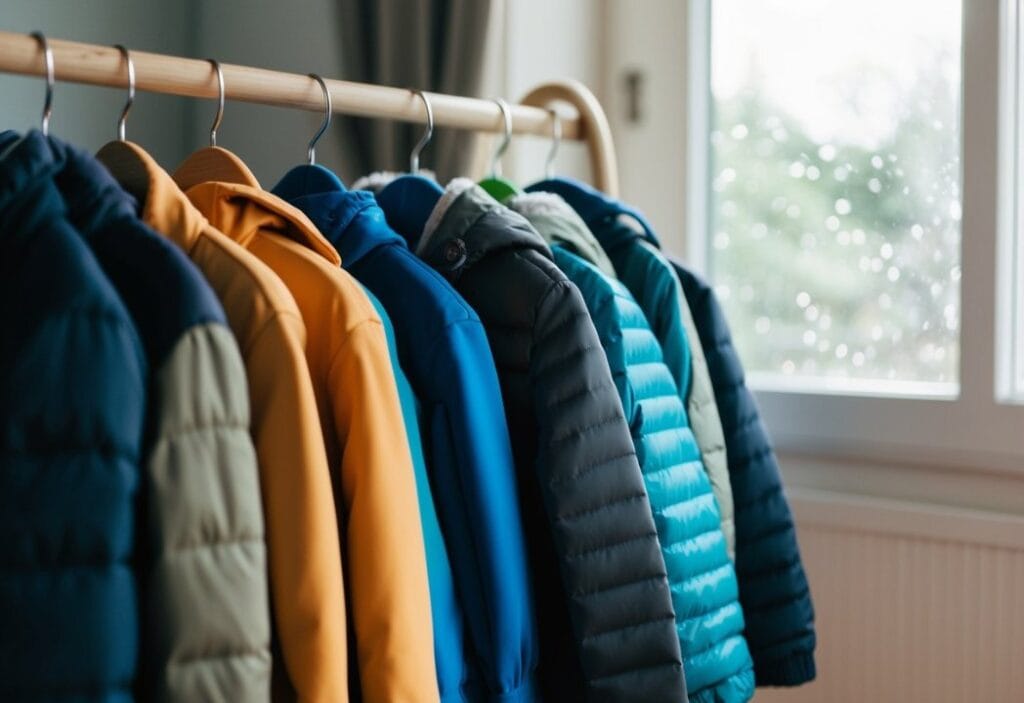
Keeping kids’ jackets in top shape takes a bit of effort. I’ll share some key tips to maintain their coats and extend their lifespan.
The Importance of Proper Preservation
Proper care for children’s jackets is crucial. It helps them last longer and stay warm. I recommend cleaning coats regularly to remove dirt and stains. For most fabrics, air drying is best. I lay the coat flat or hang it up to dry. This keeps the shape intact and prevents damage.
I also store jackets properly when not in use. Hanging them on padded hangers helps maintain their shape. For puffy coats, I use wide hangers to support the shoulders. I keep jackets in a cool, dry place to avoid mould and mildew.
Caring for Cuffs and Zips
Cuffs and zips need special attention. I check cuffs often for wear and tear. If they start to fray, I mend them quickly to prevent further damage. For zips, I keep them clean and free of dirt. A soft brush works well for this.
I use a bit of wax on sticky zips to help them glide smoothly. For metal zips, I apply a small amount of oil to prevent rust. I’m careful not to get any on the fabric, though.
I also teach kids to be gentle with zips. Pulling too hard can cause damage. By taking care of these small details, I help keep jackets looking neat and working well.

